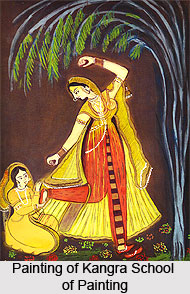Painting schools of Northern India include the various kinds of schools in the Indian states of Jammu and Kashmir and Himachal Pradesh which have patronized dexterous painters and artists since time immemorial. These painting schools have enabled the development of unique painting styles, which have been popular in India during ancient, medieval, modern and contemporary periods. Pahari Schools of painting are renowned for their contribution to the painting attitudes in Northern India, particularly the Himalayan belt comprising Jammu and Kashmir, Basohli, Kangra, Chamba, Guler, Garhwal and other regions.
 Pahari Schools of Paintings
Pahari Schools of Paintings
Spectacular paintings of Radha and Lord Krishna and Jayadev`s `Gita-Govinda` are some of the best instances of Pahari schools of paintings. It is believed that this school of painting had originated from the Mughal style of paintings and flourished due to the patronage of the Rajput rulers. Garhwal School, Kangra School, Guler School, Chamba School and Basohli School are the various kinds of Pahari schools of paintings.
Guler School of Painting
Guler School of paintings is believed to be the most ancient type of Indian paintings. Legend says that certain Hindu painters who were trained in Mughal style of paintings commenced with this technique after they sought the patronage of the Rajas of the kingdom of Guler. The art palette of Guler artists contains the colours of dawn or the rainbow. It is said that the painters of Guler School of Painting drew portraits and other forms of paintings at the place called Haripur Guler. Generally, the shades of light greens and blues are utilized in such paintings.
Garhwal School of Painting
The origin of Garhwal School of Painting can be traced back to Himachal Pradesh and was said to be inspired by the Mughal style of art. Kangra School of Painting was also responsible for imparting a distinct style to the Garhwal School of Painting. The designs used were mostly architectural patterns, human figures, landscape, attractive women with sharp facial features and narrow waistlines, etc. Therefore the theme adopted by this painting school was that of passionate romance which exuded a pleasant charm. The womenfolk of Kumaon are known for their beautiful art of `Aipan`. Garhwal paintings are considered to be one of the greatest Indian schools of paintings and are exhibited in different museums and exhibitions in Kashmir, Lucknow, Kolkata and Allahabad. Another types of paintings practiced in this school is `peeth`, wherein the seat of the floor of Hindu deities are adorned with geometrical motifs.
 Kangra School of Paintings
Kangra School of Paintings
Multiple shades of green are used to paint these paintings. The Kangra School of Paintings depict lush greenery through images of trees and plants, foliage, creepers, brooks and rivulets. A delicate appearance is often reflected in these paintings, coupled with a feminine charm. Several Kangra paintings include themes of lightning, storms and clusters of houses. Vegetable and extracts of minerals were used to manufacture the colours of these paintings.
Basohli School of Paintings
It is a general belief that Basohli paintings is among the most ancient school of Pahari paintings. These paintings later developed into the much popular Kangra paintings. The Basohli style of paintings later spread to the hilly regions of Nurpur, Bilaspur, Kangra, Nalagarh, Suket, Kulu, Mandi, Chamba, Guler and other places.
Chamba Schools of Paintings
Chamba School of paintings is famous, especially for their excellent miniature paintings which migrated from Guler to Chamba. Some distinguished painters belonging to this school are Miyan Dara Singh, Durga and Lehru. Folk art was also practiced by the Chamba painters. Chamba paintings portray the themes of Hindu myths like Yashoda, Lord Krishna, `Gopis`, Radha-Krishna and others.
The schools of paintings in Northern India have given birth to several forms of contemporary Indian painting which have been in high demand throughout the country.





